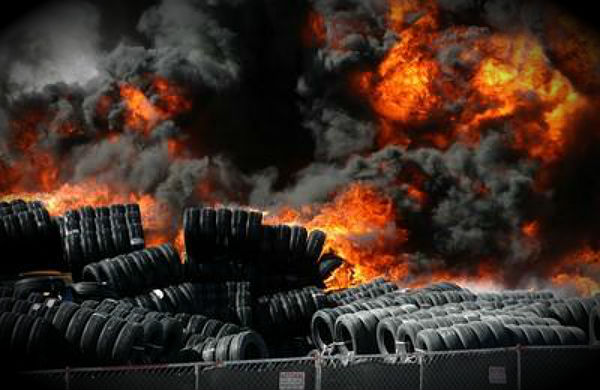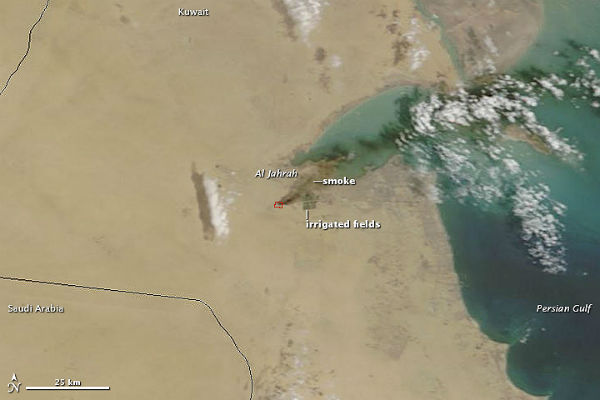Environmental catastrophe: Millions of tyres burn in Kuwait

On April 17, 2012, a massive fire broke out in a dump for used tyres in Al Jahra in north-west of Kuwait City, fuelled by around five million used tyres. The fire was raging 10 hours after it broke out as hundreds of firemen from several stations with support teams from the army, the national guard and Kuwait Oil company have been fighting to contain the fire. Environment authorities advised residents in the area to stay away and to use masks. Medics said that one man was treated for minor burns.

Authorities were grateful that winds blew most of the smoke out to sea, but members of parliament were still expected to convene a special session to discuss the fire’s environmental impact on Kuwait, news sources said. A number of MPs described the fire as an “environmental catastrophe” and vowed to demand a debate on the issue in a special parliamentary session next week. Some said they will demand an official probe.
Effects of burning tires
Burning tires releases a toxic soup of pollutants. Children are especially at risk. Hundreds of different toxic pollutants are created by burning tires as well as a tremendous number of small particles that settle deep in the lungs. Children, fetuses, nursing babies, elderly, asthmatics, immune suppressed individuals are all much more vulnerable to the pollutants released burning tires. Small particulates released by burning tires worsen asthma and may contribute to heart disease.
Tires are not designed to be burned as a fuel and contain hazardous ingredients (the rubber in tires contains 25% extender oils derived from benzene, 25% styrene, a derivative of benzene, and 25% 1,3 butadiene. – both benzene and 1,3 butadiene are suspected human carcinogens). Tire-derived fuel (TDF) also contains remnants of wire that is difficult to totally remove when tires are processed for fuel.
Fine particulates are significantly more hazardous to human health than larger particulates. Toxins collected on the surface of fine particulates are aspirated by humans and lead to lung disease. The pollution control device on the IP power boiler is insufficient to remove fine particulate matter and heavy metals from flue gases.
Inform yourself more about Hazards of Burning Tires
Sources: GulfNews, KUNA, AFP, EarthObservatory

[…] Si può fare; non c’è dubbio e non solo per i pneumatici, ma anche per certi tipi di plastiche. Ma bisogna partire da un complicato processo di separazione dei rifiuti dai quali occorre essere in grado di tirar fuori esattamente la frazione che serve. In pratica, si fa molto di rado. Si preferisce di gran lunga bruciare i rifiuti negli inceneritori e recuperare un po’ di energia in forma di calore. Anche se uno ha una bella massa di pneumatici, il processo di farne petrolio non deve essere tanto conveniente se si guardano certe cose tipo il grande incendio del deposito di gomme del Kuwait, dove hanno preso fuoco circa cinque milioni di vecchi pneumatici (per fortuna, ora sembra spento).(da TheWatchers) […]